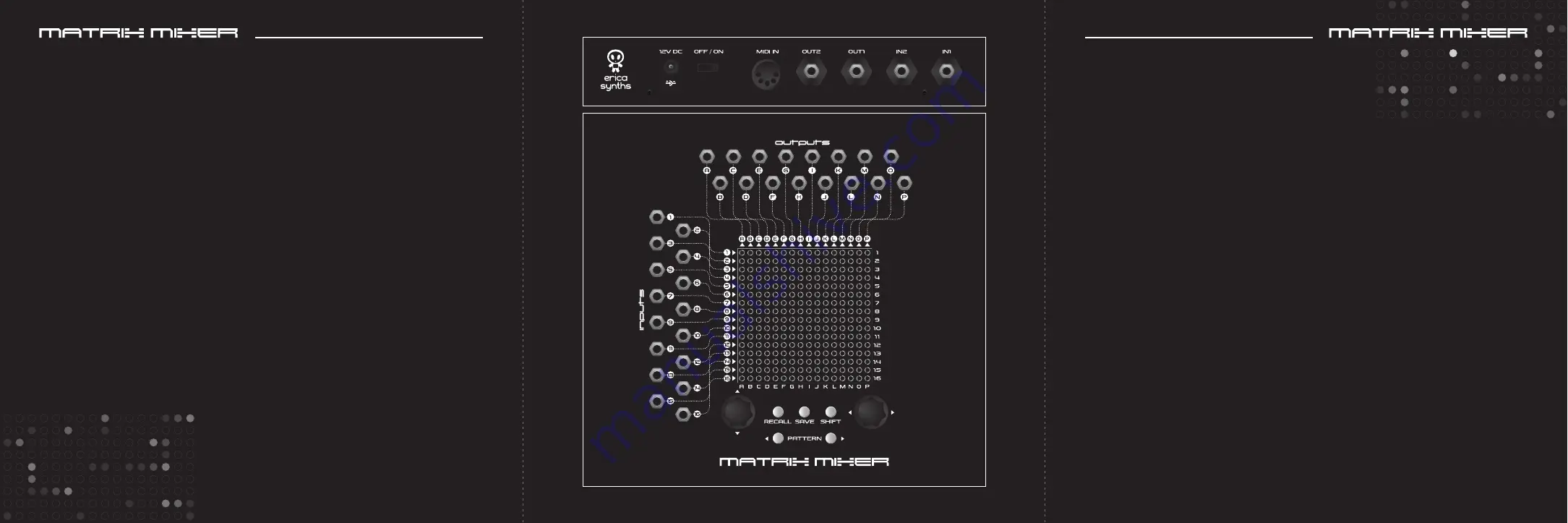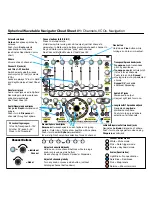
Power the Matrix Mixer exclusively with the external PSU, supplied with the instrument. Using other power supply units may
permanently damage the instrument.
Use standard 3,5mm Eurorack patch cables to connect modules or instruments to the matrix. The matrix is unidirectional,
meaning, the signal will pass from the Inputs on the left to the Outputs on top. You can send a signal from one input to
several outputs simultaneously and likewise – you can mix several inputs to one output.
On the back of the Matrix Mixer, you’ll find two 6,3mm input and two 6,3mm output sockets. These duplicate Input 1, Input 2,
Output A and Output B, respectively. The 3,5mm sockets are prioritized– if something is patched in a 3,5mm socket, the
6,3mm one is automatically disconnected.
The PATCH MATRIX has 256 possible patch points, each with three levels of attenuation, and it has a memory of 254 patches.
CONFIGURATION SETTINGS.
Push and hold the SHIFT button and push both PATTERN buttons simultaneously to access the configuration settings. There
are four configuration options, each represented on the top four rows. Use the encoders to navigate a blinking patch point
through the settings and push the left encoder to confirm a selection.
The first row represents a MIDI channel for patch changes. The leftmost point (column A on the matrix) represents MIDI
channel 1, column B – channel 2, etc.
The second row sets randomization “density” – how many connections appear simultaneously when the Random mode is
selected. A patch point in column A represents 5% density (~5% of all patch points are activated in the random patch), and
each next column adds another 5% density. Column P represents 80% density. We think more density in a random patch
doesn’t make sense.
You might want to randomize a specific area of the matrix (X columns by Y rows), while another part of the matrix
remains unaltered by randomization, therefore a user defined randomization area is implemented. The top left corner (patch
point A1) is the reference point and the third row in the configuration settings sets the number of columns for the
randomization area.
The fourth row sets the number of rows in the randomization area.
CONNECTION PREVIEW/LIVE
performance (the equivalent of making experimental sounds on the EMS
Synthi by sticking a pin into the matrix and removing it) – navigate to the
desired connection point, push and hold SHIFT and push either one of the
encoders. While the encoder is pushed, the connection is active.
RANDOM PATCHES.
Push and hold the SHIFT button and push the right PATTERN button - the Matrix Mixer will generate a random patch based
on randomization density and randomization area settings.
SAVING PATCHES.
Once you are happy with the patch, push the SAVE button, and access the “saved patches” view. Use the X/Y encoders to
navigate to a desired position and push either one of the encoders to save the patch.
NB!
Top left and bottom right
positions (half dimmed) are reserved, and you can’t access them. If you change your mind, and do not want to save the
patch, just push SAVE or SHIFT to exit to the patch building mode. The matrix automatically saves the last patch every 30”
and after power cycling it will remember the last active patch.
RECALLING PATCHES.
Push the RECALL button to access the “saved patches” mode. Use the encoders to navigate to one of the saved patches and
push either one of the encoders to recall it.
DELETING PATCHES.
Push the SAVE button. Use the encoders to navigate to the patch you wish to delete. Push and hold RECALL for more than 5”
and the LED with the patch name will turn off.
INSTANT PATCH CHANGE.
You can navigate through saved patches sequentially by pushing PATTERN buttons. This is particularly useful during
performances, when you need to change patches instantly.
PATCH CHANGE VIA MIDI.
To change a patch via MIDI you need to send Program Change messages. Bank 1 Program 1 to 128 will change the patches 1
to 128 and Bank 2 program 1 to 128 will change the patches from 128 to 254. For example, if you want to access patch
number 1 you need to send a “Bank 1, Program 1” MIDI message and if you want to access patch number 300 you need to
send a “Bank 2, Program 44” MIDI message.
NB!
Take note that the first patch is located in the 1-B slot and the last patch is
located in the 16-O slot because the 1-A and 16-P slots are reserved for displaying when you are in the Patch Recall screen!
TO BUILD A PATCH
, navigate the matrix via the X and Y encoders
and select a patch point. The left encoder allows you to make attenuated
connections. Push the encoder to make a connection. The first push,
makes a connection with a gain value of 1, the second – 0,7, the third –
0,3, and the fourth turns the connection off, and so on. The right encoder
makes a connection with a gain value of 1 and pushing it a second time
turns the connection off – basically, it works as a shortcut.




















